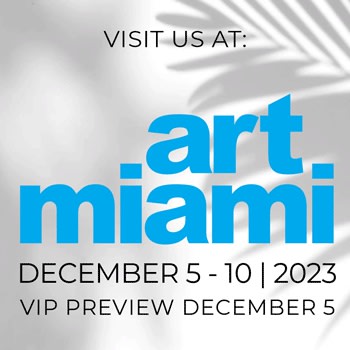Mark Grotjahn
Mark Grotjahn is an American painter and sculptor whose works have been exhibited extensively around the world and are included in the permanent collections of major museums and galleries.
Early Life and Education
Mark Grotjahn was born in Pasadena in 1968. The family moved to Marin, in the Bay Area, when he was nine months old. Both his grandfather and father, who emigrated from Germany, were psychiatrists. His grandfather’s books on Picasso, and visits to museums with his mother, were early influences.
“Janis Joplin was my dad’s only famous client.” Grotjahn said, “My grandfather started the Psychiatric Institute of Southern California. He was like the shrink to the other shrinks. And then all the stars began going to him. I would have been the sixth generation of doctors in my family. In college, I imagined that at some point I would switch over to pre-med, but I never did.”
In high school, Grotjahn was inspired by the works of Mondrian and by Wassily Kandinsky’s book Concerning the Spiritual In Art. His art teacher was very encouraging.
One of the paintings he did in high school won a national contest, for the entry from California, and was hung in the Reagan White House. “I think the story you want to hear,” Grotjahn said in an interview, “is how I did that painting on acid by our pool with my eyes closed.”
In 2016, another of Grotjahn’s works was hung in the White House. “There’s a picture online of Obama with Kanye West and Kim Kardashian with a butterfly drawing on the wall behind them.” he said. “I don’t know how they got it. They didn’t get it from me.”
Grotjahn received his BFA from the University of Colorado at Boulder and his MFA from the University of California, Berkeley. In 1995, he was an artist-in-residence at the Skowhegan School of Painting and Sculpture in Madison, Maine. Grotjahn finished the residency and moved to Los Angeles in 1996.
Career and Personal Life
While completing his MFA, Grotjahn was having difficulty finding his style. He had a wild idea, which he followed, and became the Sign Exchange. He would go to local Mom-and-Pop shops, recreate the signs that they had in their stores and ask the owners to exchange their original sign with the one he had made. As an incentive, he would use brighter colors and better materials than original sign. The project ended in 1998, when Grotjahn found began creating his own works.
In 1998, in Los Angeles, Grotjahn and his classmate, Brent Petersen, opened Room 702, a gallery where they wanted to work with and show the works of other artists. Paying the rent was difficult, and the gallery was only open for only two years. The closing of the gallery allowed Grotjahn to concentrate, once again, on his own work. He said that he was interested in color, line and perspective and is a better designer than traditional artist. The Butterfly Series was well-received and began Grotjahn’s soaring career.
Grotjahn had a ski accident in 2008. He injured his rotator cuff and broke a bone in his shoulder that made it difficult to paint for long periods of time. His solution was to paint in layers, working on cardboard mounted on linen. Grotjahn has created several series using this technique, each one with great success. He also used cardboard boxes to create masks as a fun project, then began to bronze and paint them, creating works that have been shown in museums and galleries.
“I live in a huge mansion, you know what I mean?” he said, “When I was doing the sign exchange I was living in a studio with a hot plate. Now I live in a mansion.” Grotjahn was married to artist Jennifer Guidi. The couple has two children. He is an artist trustee on the board of the Museum of Contemporary Art, Los Angeles. His work was included in the 54th Carnegie International in 2004 and the Whitney Biennial in 2006 and his works are included in the permanent collections of the Whitney, the Guggenheim, MoMA and other major venues.
He has collaborated on works with Jonas Wood and Takashi Murakami. In 2017 a new price record was set at auction when a work from his Face Series was sold for $16.8 million dollars.
References:
Robin Pogrebin. When an Artist Calls the Shots: Mark Grotjahn’s Soaring Prices. The New York Times. June 30, 2017.
John Yau. Mark Grotjahn Checks All the Boxes. Hyperallergic. December 16, 2018.
Send me more information on Mark Grotjahn
-

Surovek Gallery at Art Miami 2023
November 30, 2023At Surovek Gallery our focus is on the finest American paintings, drawings, watercolors and prints of the 19th, 20th and 21st centuries; the oeuvre which...Read more -

Jonas Wood Collaborates with the LA Clippers; Mark Grotjahn Designs Backcountry Skis
November 22, 2023Jonas Wood (b. 1977) has had another banner year. The California-based artist, who is obsessed with basketball, designed this season’s uniforms for the LA Clippers...Read more



